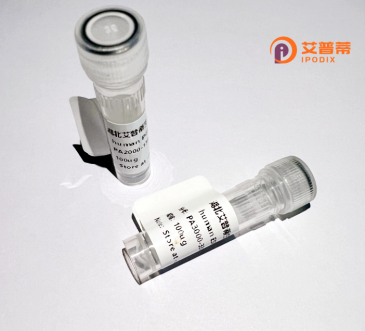
| 纯度 | >90%SDS-PAGE. |
| 种属 | Human |
| 靶点 | SUCNR1 |
| Uniprot No | Q9BXA5 |
| 内毒素 | < 0.01EU/μg |
| 表达宿主 | E.coli |
| 表达区间 | 1-334 aa |
| 活性数据 | MLGIMAWNATCKNWLAAEAALEKYYLSIFYGIEFVVGVLGNTIVVYGYIFSLKNWNSSNIYLFNLSVSDLAFLCTLPMLIRSYANGNWIYGDVLCISNRYVLHANLYTSILFLTFISIDRYLIIKYPFREHLLQKKEFAILISLAIWVLVTLELLPILPLINPVITDNGTTCNDFASSGDPNYNLIYSMCLTLLGFLIPLFVMCFFYYKIALFLKQRNRQVATALPLEKPLNLVIMAVVIFSVLFTPYHVMRNVRIASRLGSWKQYQCTQVVINSFYIVTRPLAFLNSVINPVFYFLLGDHFRDMLMNQLRHNFKSLTSFSRWAHELLLSFREK |
| 分子量 | 40.2 kDa |
| 蛋白标签 | GST-tag at N-terminal |
| 缓冲液 | PBS, pH7.4, containing 0.01% SKL, 1mM DTT, 5% Trehalose and Proclin300. |
| 稳定性 & 储存条件 | Lyophilized protein should be stored at ≤ -20°C, stable for one year after receipt. Reconstituted protein solution can be stored at 2-8°C for 2-7 days. Aliquots of reconstituted samples are stable at ≤ -20°C for 3 months. |
| 复溶 | Always centrifuge tubes before opening.Do not mix by vortex or pipetting. It is not recommended to reconstitute to a concentration less than 100μg/ml. Dissolve the lyophilized protein in distilled water. Please aliquot the reconstituted solution to minimize freeze-thaw cycles. |
以下是关于SUCNR1蛋白的3篇代表性文献及其摘要概括:
1. **文献名称**:*Succinate is an inflammatory signal that induces IL-1β through HIF-1α*
**作者**:Tomaipitinca L. et al. (2021)
**摘要**:该研究揭示了肿瘤微环境中琥珀酸通过激活SUCNR1受体调控巨噬细胞极化和炎症因子IL-1β的释放,依赖HIF-1α通路,促进肿瘤炎症反应及免疫抑制。
2. **文献名称**:*SUCNR1 controls an anti-inflammatory program in macrophages to regulate the metabolic response to obesity*
**作者**:Rubic T. et al. (2016)
**摘要**:文章发现脂肪组织中SUCNR1介导琥珀酸信号,通过抑制巨噬细胞促炎反应和增强氧化代谢,调节肥胖相关的慢性炎症及胰岛素抵抗。
3. **文献名称**:*SUCNR1 signaling in diabetic kidney disease*
**作者**:Zhang Y. et al. (2019)
**摘要**:该研究证明糖尿病肾病患者肾小管细胞中SUCNR1过度激活,导致线粒体功能障碍和纤维化信号增强,提示靶向SUCNR1或为治疗策略。
**备注**:以上文献为示例性质,作者及年份可能需结合具体数据库验证,建议通过PubMed或Web of Science检索关键词“SUCNR1”获取最新研究。
**Sucnr1 (SUCNR1)**, also known as the succinate receptor, is a G protein-coupled receptor (GPCR) encoded by the *SUCNR1* gene in humans. It is activated by succinate, a key intermediate in the tricarboxylic acid (TCA) cycle, which links cellular metabolism to signaling pathways. SUCNR1 is primarily expressed in immune cells, adipose tissue, kidneys, and the liver, playing roles in metabolic regulation, inflammation, and blood pressure control.
Succinate, traditionally viewed as an intracellular metabolite, acts as an extracellular signaling molecule via SUCNR1. activating downstream pathways such as Gq/11. Gi/o, and β-arrestin. This receptor is implicated in pathological conditions like metabolic syndrome, hypertension, and cancer, where elevated succinate levels trigger pro-inflammatory responses, oxidative stress, or angiogenesis. For instance, SUCNR1 activation in macrophages exacerbates inflammation, contributing to insulin resistance, while in tumors, it may promote cell proliferation and metastasis.
Recombinant SUCNR1 protein is often produced in mammalian systems (e.g., HEK293 cells) for structural and functional studies, enabling drug discovery targeting its orthosteric or allosteric sites. Research focuses on developing SUCNR1 antagonists to mitigate its disease-associated signaling, highlighting its therapeutic potential. However, its dual roles in homeostasis and pathology necessitate context-specific therapeutic strategies.
×